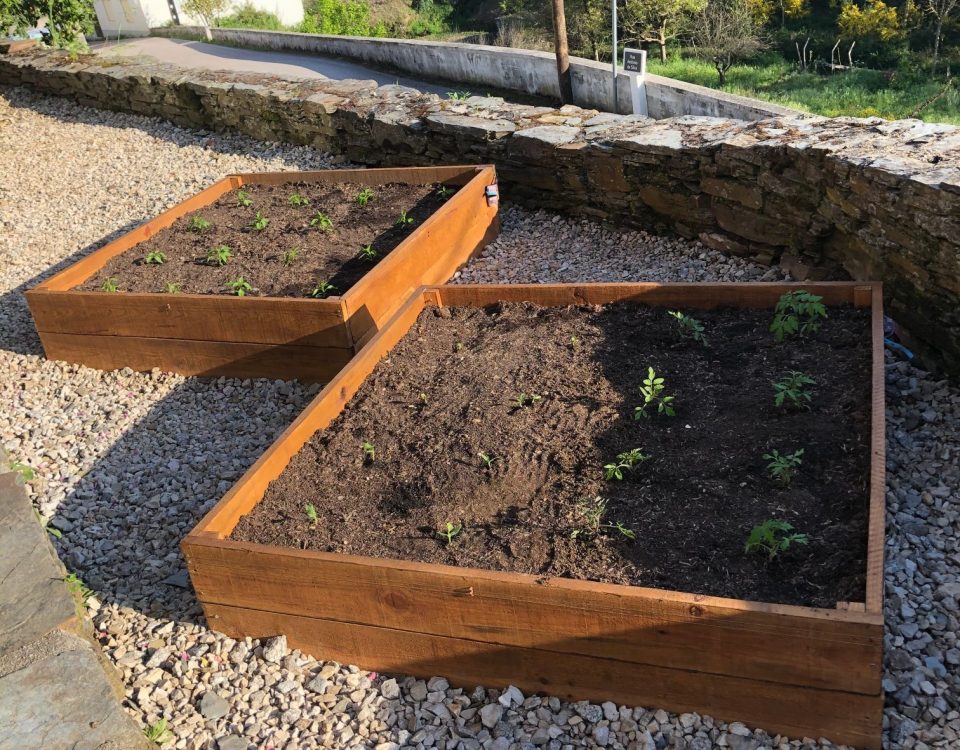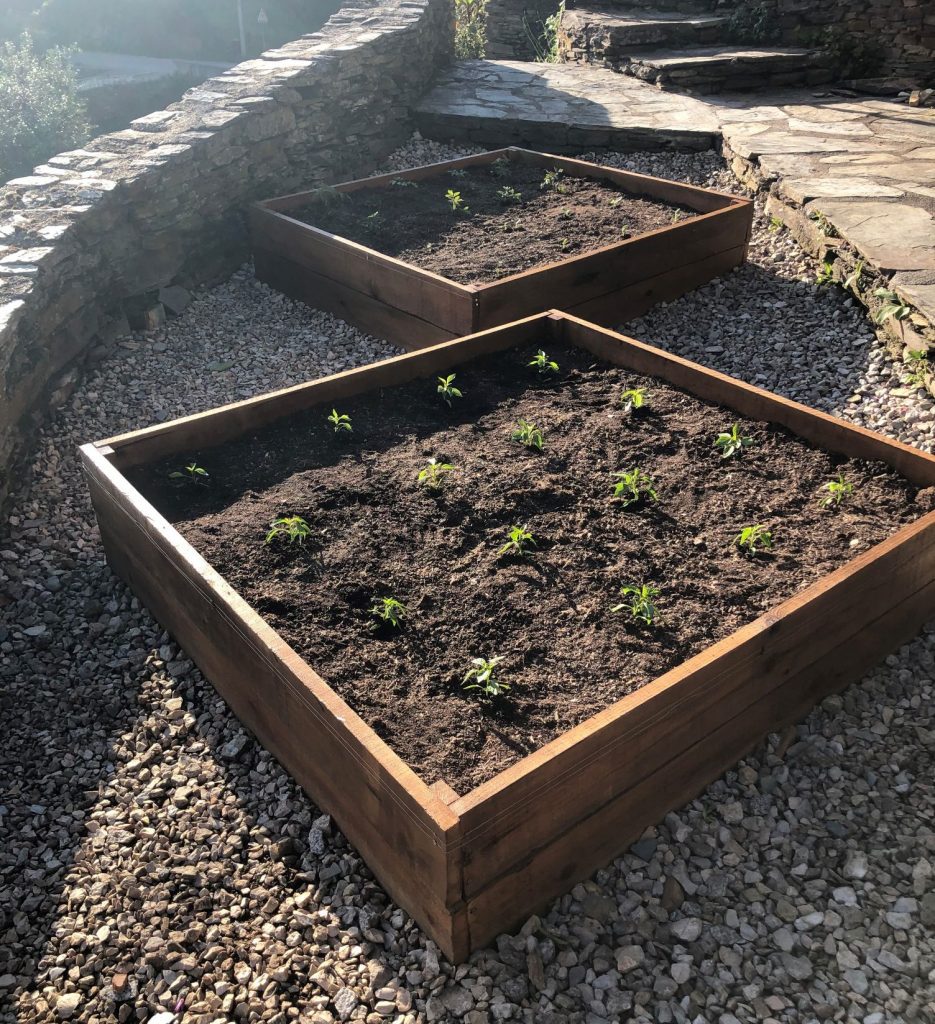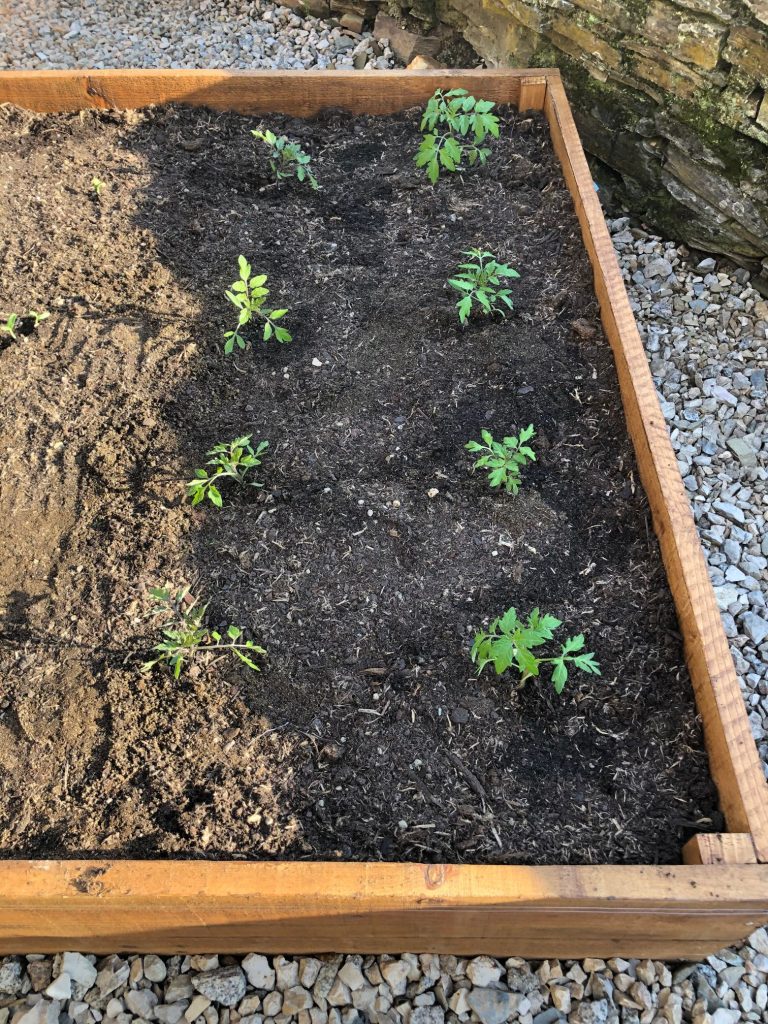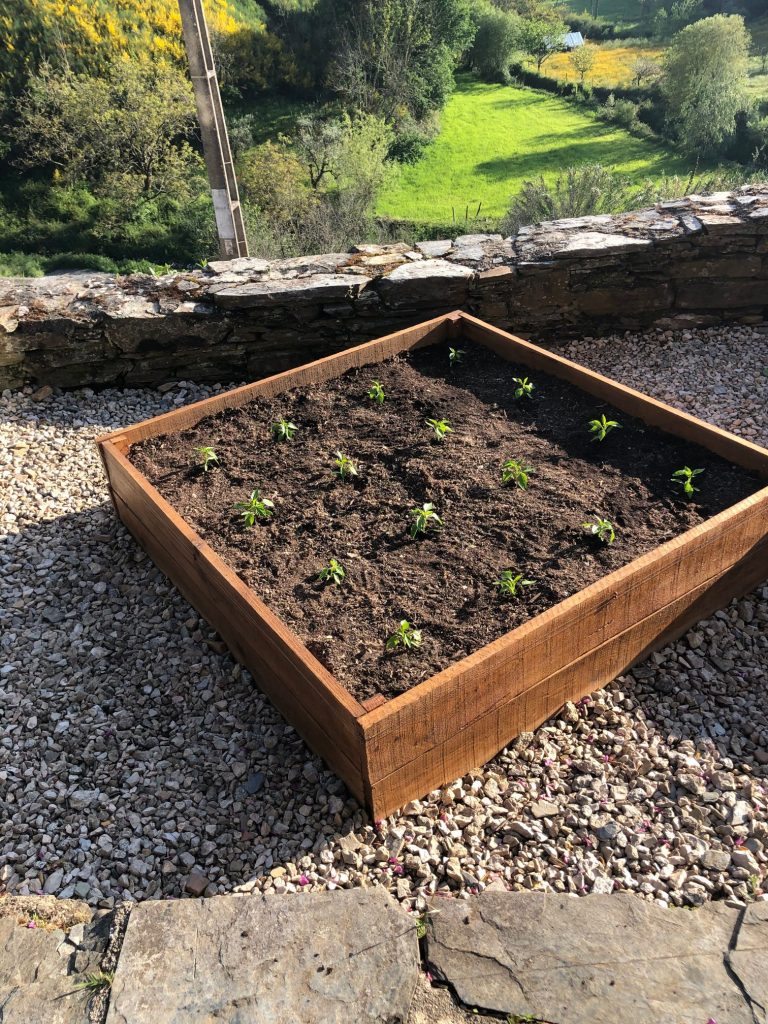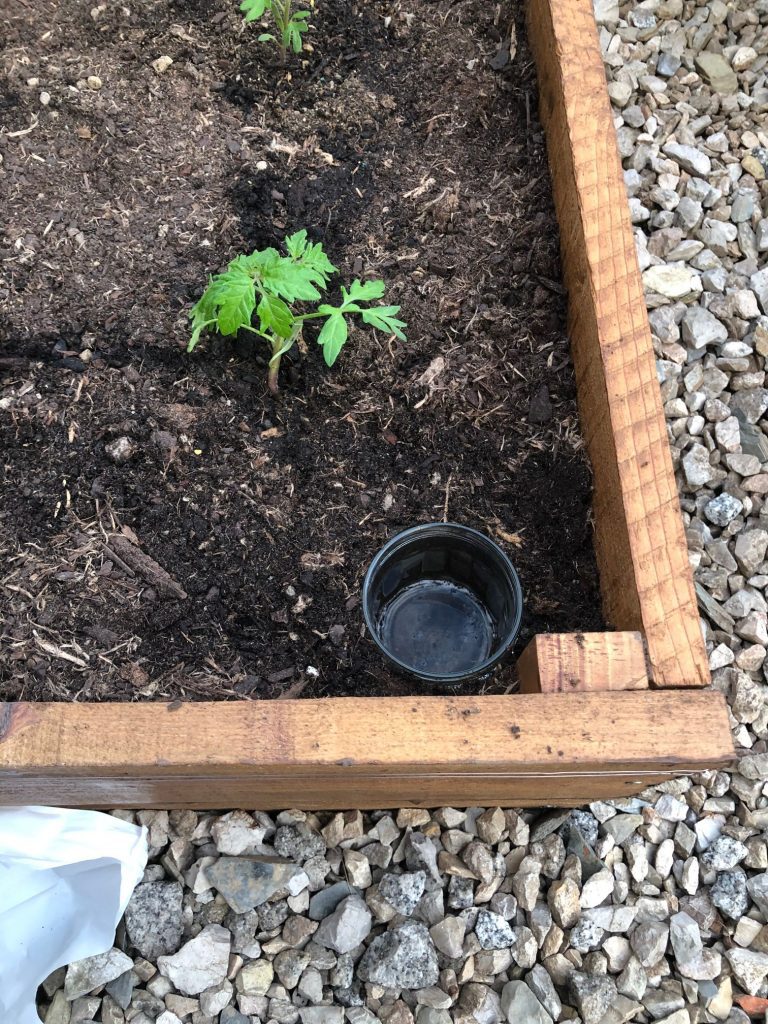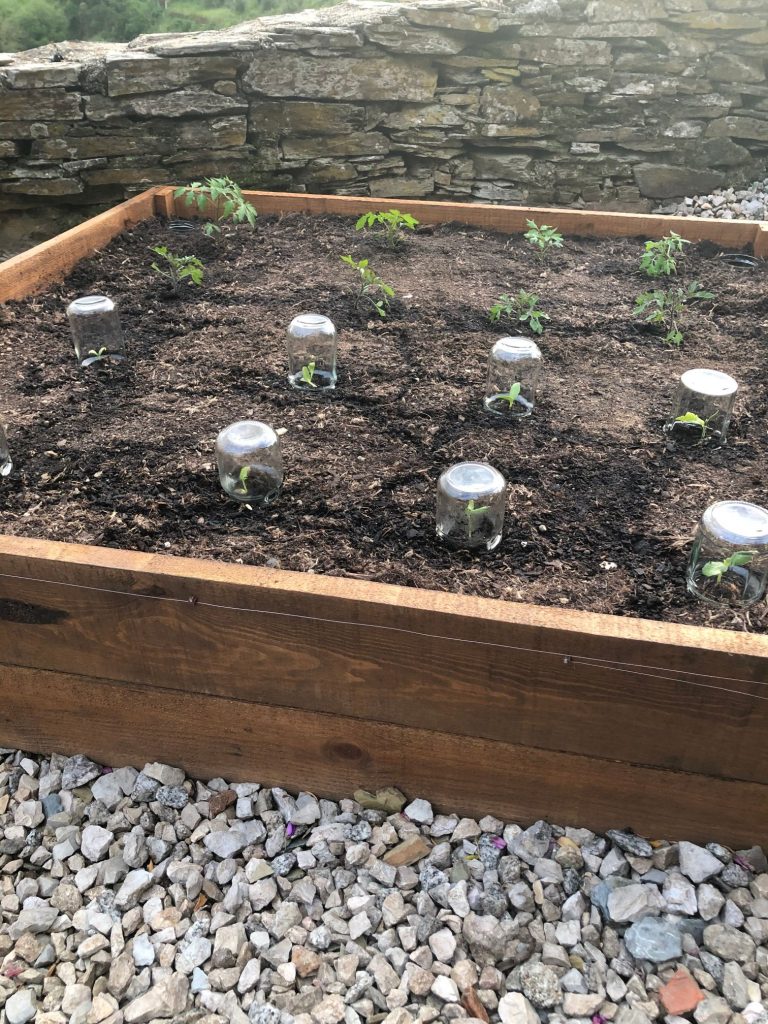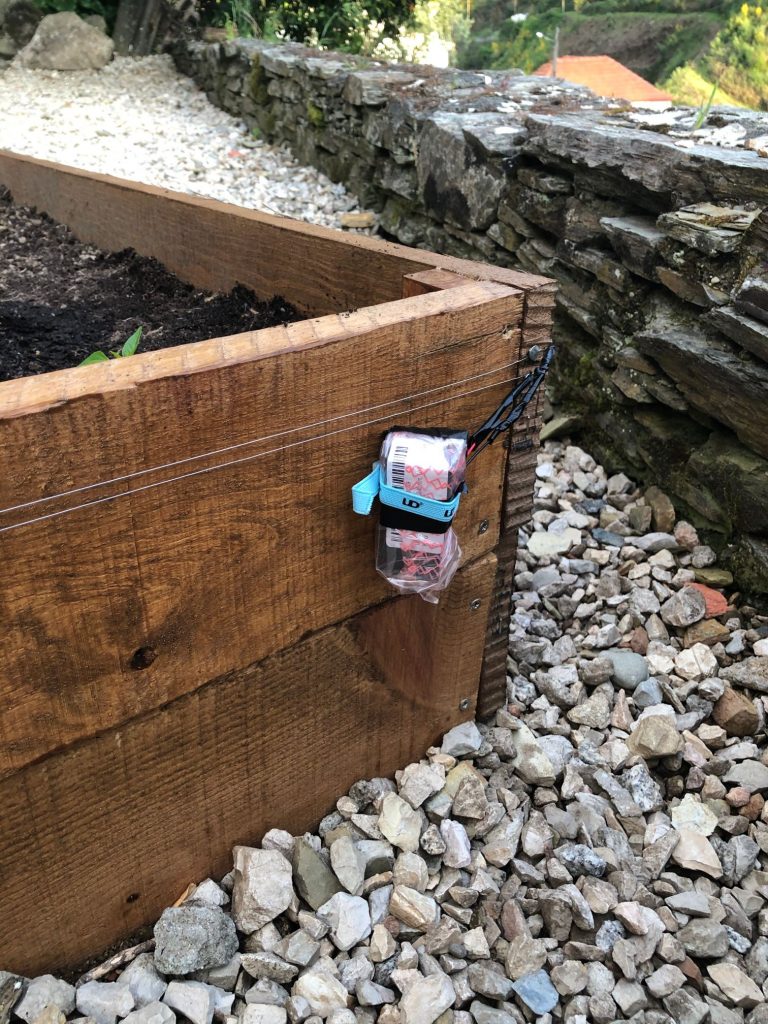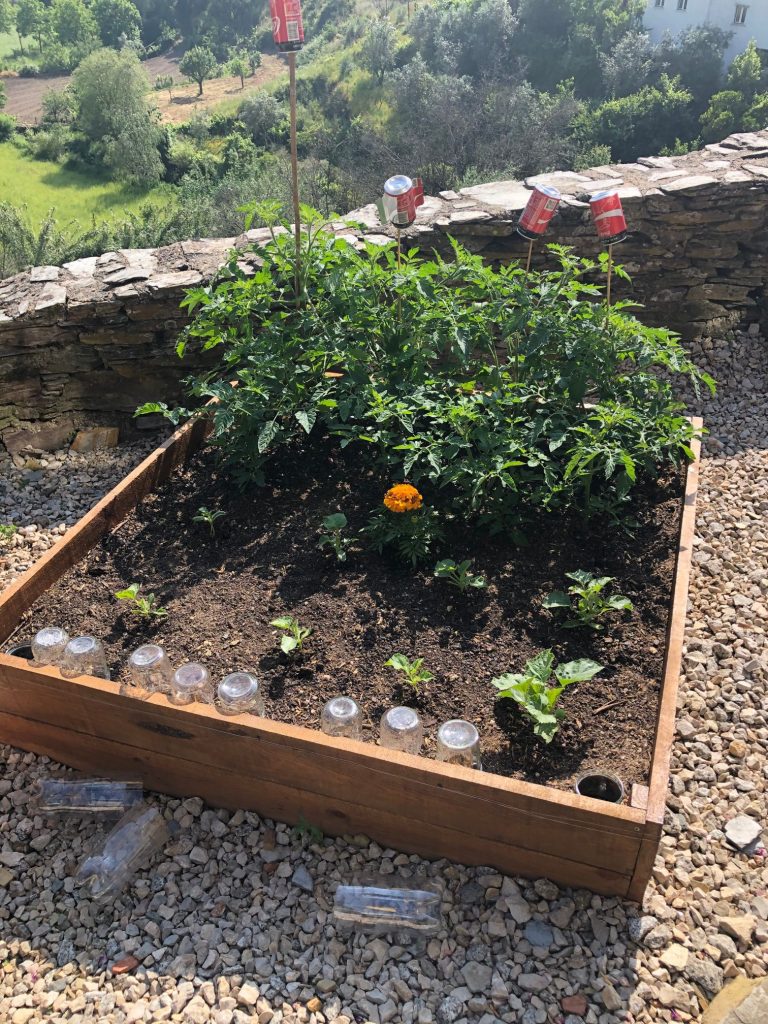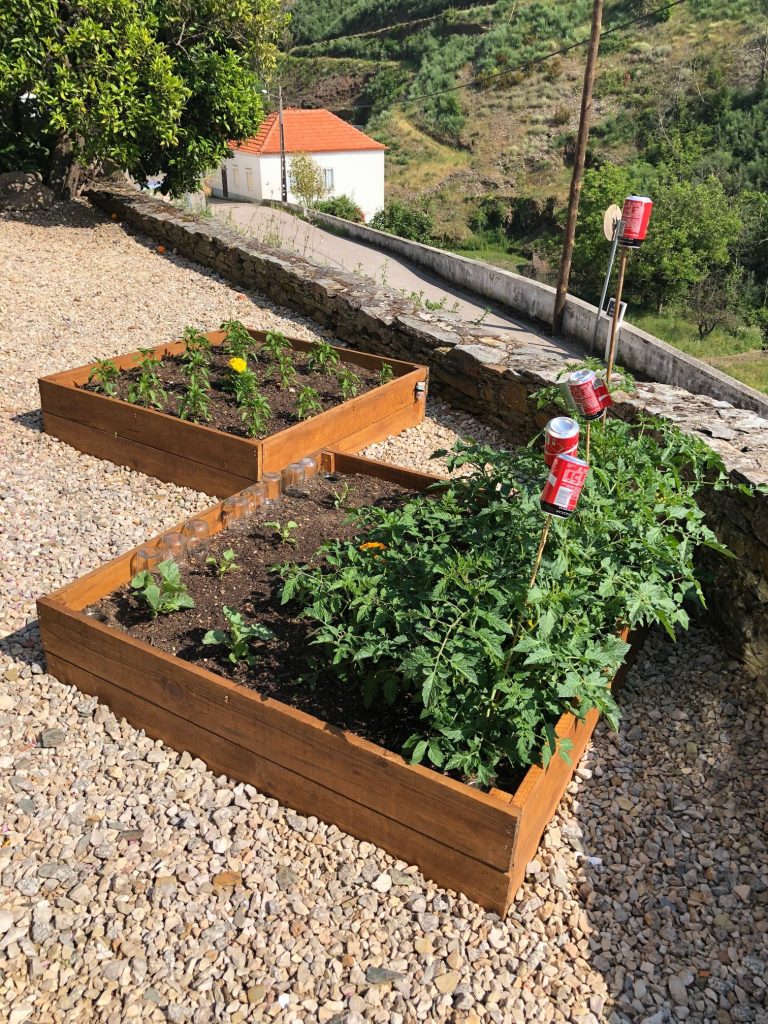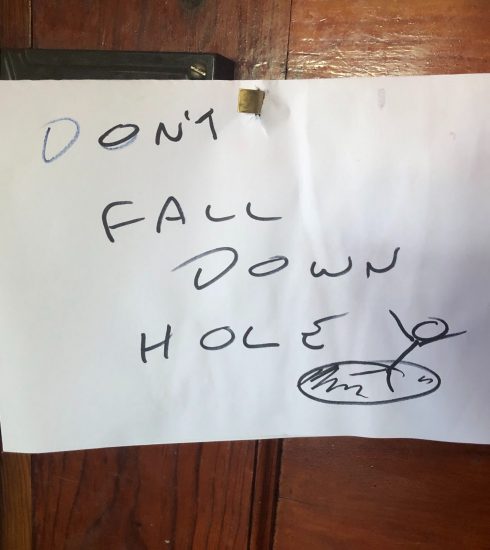RAISED BEDS, ELECTRIC FENCES AND A BOTTLE OF BEER
After all that nasty rain we eventually just had a glorious sunny weekend in the garden which enabled us to finish off pest proofing the raised beds and plant out the seedlings.
Why?
You may be aware from reading my Gardening and wildlife post that our garden is a little unique as it’s not acres of flat land but different tiers of garden. The lower front border section was covered in weeds and decorative stone pebbles when we purchased the house and we thought that was such a waste of land to just cover it and not grow some tasty organic edible crops. After a long task of removing all the pebbles we were faced with a lot of uneven concrete at one end and limited soil so instead of 4 raised beds as initially planned we ended up with 2.
I don’t think our vegetable plot will make us self-sufficient any time soon. Despite this, I really enjoy growing my own food from seed and watching the progress of each plant. It is very satisfying nurturing a tiny seedling and home grown always tastes so much better than shop bought. I am especially excited about growing melons for the first time, I do hope they thrive or just survive! I sing to them daily which obviously helps – Portuguese rap music usually which they especially enjoy. We are having a lot of rain at present so I asked my Facebook gardening friends what you can do as our lemon tree looks half dead. Many say it’s either not enough water or too much water. Although I have magical powers (as I was a purple unicorn in my previous life) unfortunately I am unable to control the rain – it’s pouring down right now! Maybe I should buy mini guarda chuvas for my plants!
Advantages
There are many advantages of having a raised bed:
- Better drainage.
- Help keep out critters – barrier for pests.
- Prevents erosion – avoid plants growing into our wall and foundations preventing a collapse of our unsteady wall and soil eroding down the slope.
- No need for tilling.
- Grow different plants that need certain soils as you can fill with your own loam.
- Weed reduction – less chance weed spread.
- Raised beds can be installed on concrete.
- Less soil compaction as it’s not walked on.
- Looks nice.
- Ergonomic options – you can build higher beds to prevent strain on the back, neck and shoulders.
- Good for people with restricted mobility or wheelchair users.
Size matters! (Don’t let anyone tell you otherwise)
Our raised beds are not particularly high and they are on top of soil not a hard concrete base. If on top of a hard surface you will need a good height so plants can root deeply. If on top of soil anywhere from 6 inches high to waist height is fine. We were not aiming for the really tall beds that save your back as we did not want them to be visible from the road or block any view from our sun room. We thought that X4 beds that were approx. 4ft X 4ft would work for us as we would be able to reach the middle easily and have space for a pebble pathway in between. We found that the wood here was 2.6m in length so got it cut in half and ended up with 2 beds 1.3×1.3m but twice the height that we originally planned as we had purchased wood for the original 4 beds. Unless you have Inspector Gadget arms (I’m showing my age now!) you won’t want any wider than around 4ft across or you won’t be able to reach the middle of the bed. Height wise each plank is approx. 20cm and depth is 3cm.
Do you need to get a lawnmower or wheelbarrow through the pathway between the beds? Give space to walk and mow if necessary. We just needed space to walk.
Materials?
Many materials can be used to make a raised bed such as wooden timber planks, pallets, railway sleepers/logs, stone, bricks, concrete blocks, recycled plastic, corrugated roofing sheets, roof tiles, tires, willow etc. I’ve even viewed some patio bidets used as planters here so anything goes. If you want totally organic then beware some materials may leak toxins into the soil. We purchased the cheapest untreated wooden planks from Leeroy Merlin and got them to cut it for us. We purchased X8 planks of wood 2.6m in length and got them cut in half to measure 1.3m in length. For the posts we purchased a much narrower plank of wood in the same size length of 2.6m then asked them to cut it into 8 equal pieces of 32.5cm. We then purchased a toxic free preservative to treat the wood. You can buy pre treated or heat pressured wood which is a bit more expensive but we wanted to preserve our own so we knew it was toxic free as we want to grow totally organic plants. Then you need lots of screws, an electric drill and a screwdriver. We didn’t use a spirit level, because we wanted really unleveled raised beds to add to the rustic quirky charm of the house (ha ha), it’s not that we couldn’t be bothered to go back into the house to fetch it as that would be super lazy!
How? (Makes 2 raised beds)
- Paint 2 coats of wood preservative. Allow adequate time in between coats to dry.
- Firstly attach 2 of the posts (1 at each end) to 1 of the planks, by using a clamp and drilling a small hole in the plank to screw the screw into. Make sure the plank is level to the top of the post.
- Injure yourself then swear in Portuguese (because you are allowed to) – repeat mantra ‘Still living the dream’.
- Then attach the second plank underneath the first one to provide the height. This will provide a small amount of excess wood at the bottom of the post so you can stake it into the ground for stability.
- Shout at hubby for not holding the wood correctly and for not fetching the spirit level.
- Repeat the above steps 3 more times.
- Then you attach the 2 double side planks by again drilling small holes and screwing in screws to the posts that are already there. Apologies, I should of took step by step photos.
What to fill it with?
A mix of topsoil, compost and other organic material such as manure so your plants will have the benefit of a nutrient rich environment. We wanted to fill our beds without spending a fortune so we recycled soil from our garden then purchased 4 bags of compost and mixed in some chicken fertilizer and horse manure – dried and well rotted, not the fresh manure.
If your soil has lots of stones, don’t worry. Try and pick out any larger stones but don’t worry too much as stones provide great drainage and unless you are growing lots of root vegetables it won’t matter too much.
Some people line their beds with landscaping fabric but it all depends what you want to grow and if your bed is on top of grass. If you only want to grow shallow rooted crops and you are worried about nearby tree roots getting into the beds then lining is fine. Raised beds are best erected a good distance away from trees. Do not line beds with plastic sheeting as this prevents no drainage so beds may get waterlogged.
Mulch is important to provide moisture and prevents weeds. You can use straw, leaves, grass clippings, wood chippings etc.
Some folk rave about the lasagne method where you layer. I don’t know much about this and when I asked my Facebook gardening friends what to fill my raised beds with one just simply replied ‘Lasagne’ and I wanted to reply ‘Not a very Portuguese meal but yes please, can you leave it on the doorstep as we are social distancing’.
What to plant?
There are several websites with detailed planning guides and tips for rotating crops. We just googled which plants are compatible and grow well together and which should not be planted together and followed these rules.
I don’t know why people grow crops that they don’t like the taste of. We are planting edible crops to eat and have just planted out tomatoes, chillies and melons so far which we grew from seed. We also have Portuguese cabbages and a variety of different tomatoes. I really want to grow bananas but I think they would not survive as it’s not hot enough here, maybe they would grow in the Algarve.
Watering/Irrigation
There are several methods but we just water by hand and hose or let the rain do it’s job. Raised beds will dry out quicker than a normal garden especially around edges so monitor closely and don’t forget to sing ‘It’s raining men’ is a good song.
Pathways
You can use many materials for your pathway e.g. cardboard, straw, pebbles, stone paving slabs. stepping stones, pea gravel, bricks, mulch, wood chips, grass, clover etc. We recycled the stone pebbles.
How to deter pests?
There are many options available and different options work for different people. We have an abundance of slugs and snails in our garden so I wanted a strong method as it’s heartbreaking to lose your crops to pests once you have worked so hard growing them from seed.
Just some of the methods I know about:
- Pesticides.
- Egg shells crushed up. Also provides calcium.
- Coffee.
- Salt.
- Chalk.
- Beer traps – for the slugs not my hubby!
- Electric fence.
- Copper tape.
- Human hair – yuk, should have saved hubby’s hair from his recent Covid cut but piles of it around the garden just to prevent the odd deer would make me gag (ha ha).
- Cayenne pepper.
- Soapy water.
- Fake snakes – with my poor eyesight I’d probably give myself a daily heart attack!
- Foil balloons.
- Scarecrows.
- Herbs and plants with strong aroma.
- Cloches, mesh wire and netting.
- Jam jars over small seedlings overnight.
- The run outside at midnight and pick them off wearing a head torch method – admit it we have all done it!
Plan A:
I was saving coffee leftover grinds from my espresso maker and egg shells but when I opened the containers some were mouldy. I put the eggs in the microwave to kill the bacteria and crushed them up but there were not enough egg shells for our 2 raised beds so I opted for the beer traps and the electric fence. I read that the only method that works 100 percent was the electric current wire method so we have given it a go. This consists of purchasing stainless steel wire on a real with a 9 volt battery and battery holder case (all purchased from Amazon UK). You wrap 2 layers around the bed and the idea is when the slug slithers over the second wire it zaps them with electricity.
Apparently the 9 volts just shocks the pest and gives it an unpleasant sensation and it doesn’t kill it. Hubby explained it’s like when you used to put a 9 volt battery on your tongue as a child, WTF! I’m not sure what shit went down in Stroud where he grew up but there was none of this craziness going down in Bristol. Maybe it’s like a mild police taser (not that I’ve ever been tasered by the police, but there’s still time ha ha). I was arrested once but they didn’t taser me as I fully cooperated and was let off with a caution. I did receive an electric shock once from an electric fence surrounding a horse stables. I used to live opposite a stables in Longwood, Broomhill, Bristol and once took a cut through the horse field to talk to the owner about hiring her field and tried to squeeze through the fence, which I didn’t know was an electric fence. If it’s anything like this, the slugs won’t wanna return in a hurry, it was painful as hell. In hindsight if I knew it was an electric fence I wouldn’t have hired it for a birthday party with bouncy castle in a field for my then 8 year old daughter. Shouting at a bunch of 8 year olds and trying to get them to avoid touching the fence was stressful, You live and learn!
Plan B:
I also sunk X4 jam jars with beer in each corner of the beds. Hubby is going to be wondering where his beer is later tonight. I am not sure if I should tell him I’ve offered it to the slugs or maybe just tell him I was having a bad day so drunk it whilst he was on the loo. I think I will let him search for it for about an hour then explain – we know how to have fun in lock down!
I am also going to put some mesh over the top as I am concerned other creatures may want a nibble in the night e.g. moles or even cats might want to run through the beds. I am hoping that our crops will survive and we have limited casualties but only time will tell.
Maintenance
Add compost or composted manure annually before spring.
Rotate your crop each year to prevent pests and diseases.
I am hoping the wood will last for 5 years or so and if I’m not dead by then I can replace or fix and recycle.
I’m very proud of our raised beds as we usually just make a mess.
Update
I’m reading an interesting article on Hugelkultur, pronounced, “Hoo-Gul-Culture,” means hill culture or hill mound in German. Hugelkultur raised beds are no-dig raised beds that hold moisture, build fertility and maximise surface volume so that you get double the yield when harvest time comes. I may try this in the secret garden.

